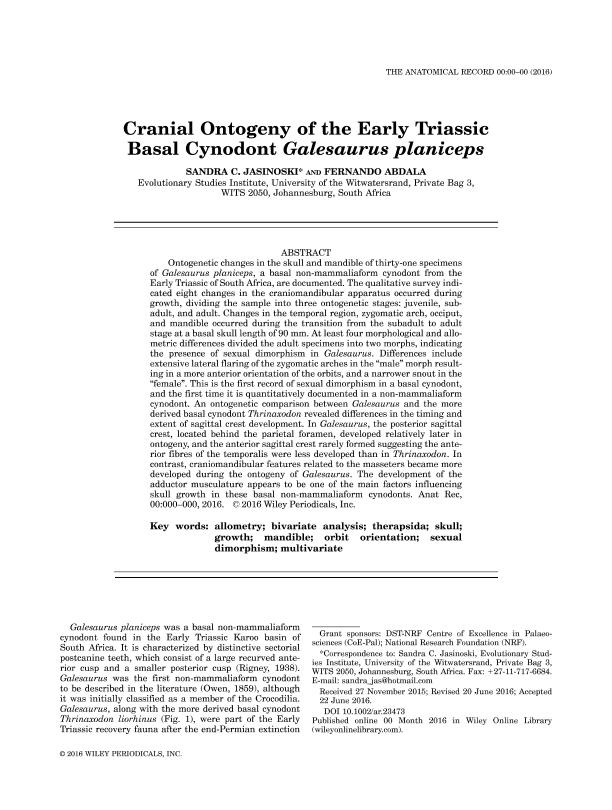Mostrar el registro sencillo del ítem
dc.contributor.author
Jasinoski, S. C.
dc.contributor.author
Abdala, Nestor Fernando

dc.date.available
2018-12-21T19:56:34Z
dc.date.issued
2017-02
dc.identifier.citation
Jasinoski, S. C.; Abdala, Nestor Fernando; Cranial Ontogeny of the Early Triassic Basal Cynodont Galesaurus planiceps; Wiley-liss, Div John Wiley & Sons Inc; Anatomical Record-Advances in Integrative Anatomy and Evolutionary Biology; 300; 2; 2-2017; 353-381
dc.identifier.issn
1932-8486
dc.identifier.uri
http://hdl.handle.net/11336/66934
dc.description.abstract
Ontogenetic changes in the skull and mandible of thirty-one specimens of Galesaurus planiceps, a basal non-mammaliaform cynodont from the Early Triassic of South Africa, are documented. The qualitative survey indicated eight changes in the craniomandibular apparatus occurred during growth, dividing the sample into three ontogenetic stages: juvenile, subadult, and adult. Changes in the temporal region, zygomatic arch, occiput, and mandible occurred during the transition from the subadult to adult stage at a basal skull length of 90 mm. At least four morphological and allometric differences divided the adult specimens into two morphs, indicating the presence of sexual dimorphism in Galesaurus. Differences include extensive lateral flaring of the zygomatic arches in the “male” morph resulting in a more anterior orientation of the orbits, and a narrower snout in the “female”. This is the first record of sexual dimorphism in a basal cynodont, and the first time it is quantitatively documented in a non-mammaliaform cynodont. An ontogenetic comparison between Galesaurus and the more derived basal cynodont Thrinaxodon revealed differences in the timing and extent of sagittal crest development. In Galesaurus, the posterior sagittal crest, located behind the parietal foramen, developed relatively later in ontogeny, and the anterior sagittal crest rarely formed suggesting the anterior fibres of the temporalis were less developed than in Thrinaxodon. In contrast, craniomandibular features related to the masseters became more developed during the ontogeny of Galesaurus. The development of the adductor musculature appears to be one of the main factors influencing skull growth in these basal non-mammaliaform cynodonts. Anat Rec, 300:353–381, 2017. © 2016 Wiley Periodicals, Inc.
dc.format
application/pdf
dc.language.iso
eng
dc.publisher
Wiley-liss, Div John Wiley & Sons Inc

dc.rights
info:eu-repo/semantics/openAccess
dc.rights.uri
https://creativecommons.org/licenses/by-nc-sa/2.5/ar/
dc.subject
Allometry
dc.subject
Bivariate Analysis
dc.subject
Growth
dc.subject
Mandible
dc.subject
Multivariate
dc.subject
Orbit Orientation
dc.subject
Sexual Dimorphism
dc.subject
Skull
dc.subject
Therapsida
dc.subject.classification
Meteorología y Ciencias Atmosféricas

dc.subject.classification
Ciencias de la Tierra y relacionadas con el Medio Ambiente

dc.subject.classification
CIENCIAS NATURALES Y EXACTAS

dc.title
Cranial Ontogeny of the Early Triassic Basal Cynodont Galesaurus planiceps
dc.type
info:eu-repo/semantics/article
dc.type
info:ar-repo/semantics/artículo
dc.type
info:eu-repo/semantics/publishedVersion
dc.date.updated
2018-12-19T14:42:22Z
dc.journal.volume
300
dc.journal.number
2
dc.journal.pagination
353-381
dc.journal.pais
Estados Unidos

dc.journal.ciudad
Nueva York
dc.description.fil
Fil: Jasinoski, S. C.. University of the Witwatersrand; Sudáfrica
dc.description.fil
Fil: Abdala, Nestor Fernando. Consejo Nacional de Investigaciones Científicas y Técnicas; Argentina. University of the Witwatersrand; Sudáfrica
dc.journal.title
Anatomical Record-Advances in Integrative Anatomy and Evolutionary Biology

dc.relation.alternativeid
info:eu-repo/semantics/altIdentifier/doi/https://dx.doi.org/10.1002/ar.23473
dc.relation.alternativeid
info:eu-repo/semantics/altIdentifier/url/https://onlinelibrary.wiley.com/doi/full/10.1002/ar.23473
Archivos asociados
